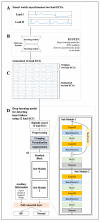Artificial Intelligence-Enhanced Smartwatch ECG for Heart Failure-Reduced Ejection Fraction Detection by Generating 12-Lead ECG
- PMID: 35328207
- PMCID: PMC8947562
- DOI: 10.3390/diagnostics12030654
Artificial Intelligence-Enhanced Smartwatch ECG for Heart Failure-Reduced Ejection Fraction Detection by Generating 12-Lead ECG
Abstract
Background: We developed and validated an artificial intelligence (AI)-enabled smartwatch ECG to detect heart failure-reduced ejection fraction (HFrEF).
Methods: This was a cohort study involving two hospitals (A and B). We developed the AI in two steps. First, we developed an AI model (ECGT2T) to synthesize ten-lead ECG from the asynchronized 2-lead ECG (Lead I and II). ECGT2T is a deep learning model based on a generative adversarial network, which translates source ECGs to reference ECGs by learning styles of the reference ECGs. For this, we included adult patients aged ≥18 years from hospital A with at least one digitally stored 12-lead ECG. Second, we developed an AI model to detect HFrEF using a 10 s 12-lead ECG. The AI model was based on convolutional neural network. For this, we included adult patients who underwent ECG and echocardiography within 14 days. To validate the AI, we included adult patients from hospital B who underwent two-lead smartwatch ECG and echocardiography on the same day. The AI model generates a 10 s 12-lead ECG from a two-lead smartwatch ECG using ECGT2T and detects HFrEF using the generated 12-lead ECG.
Results: We included 137,673 patients with 458,745 ECGs and 38,643 patients with 88,900 ECGs from hospital A for developing the ECGT2T and HFrEF detection models, respectively. The area under the receiver operating characteristic curve of AI for detecting HFrEF using smartwatch ECG was 0.934 (95% confidence interval 0.913-0.955) with 755 patients from hospital B. The sensitivity, specificity, positive predictive value, and negative predictive value of AI were 0.897, 0.860, 0.258, and 0.994, respectively.
Conclusions: An AI-enabled smartwatch 2-lead ECG could detect HFrEF with reasonable performance.
Keywords: artificial intelligence; deep learning; electrocardiography; heart failure.
Conflict of interest statement
K.-H.K. and S.Y.L. declare that they have no competing interests. J.-m.K. is co-founder and Y.-Y.J., MS Lee, S K., and S.-Y.L. are researchers of Medical AI Inc., a medical artificial intelligence company. J.-m.K. is a researcher of Body friend Co., Ltd. There are no products in development or marketed products to declare. This does not alter our adherence to this journal.
Figures




References
-
- GBD 2017 Disease and Injury Incidence and Prevalence Collaborators Global, Regional, and National Incidence, Prevalence, and Years Lived with Disability for 354 Diseases and Injuries for 195 Countries and Territories, 1990–2017: A Systematic Analysis for the Global Burden of Disease Study. [(accessed on 8 October 2021)];Lancet. 2018 392:1789–1858. doi: 10.1016/S0140-6736(18)32279-7. Available online: http://www.ncbi.nlm.nih.gov/pubmed/30496104. - DOI - PMC - PubMed
-
- Lam C.S.P., Gamble G.D., Ling L.H., Sim D., Leong K.T.G., Yeo P.S.D., Ong H.Y., Jaufeerally F., Ng T.P., Cameron V.A., et al. Mortality associated with heart failure with preserved vs. reduced ejection fraction in a prospective international multi-ethnic cohort study. [(accessed on 8 October 2021)];Eur. Heart J. 2018 39:1770–1780. doi: 10.1093/eurheartj/ehy005. Available online: http://www.ncbi.nlm.nih.gov/pubmed/29390051. - DOI - PubMed
-
- Virani S.S., Alonso A., Benjamin E.J., Bittencourt M.S., Callaway C.W., Carson A.P., Chamberlain A.M., Chang A.R., Cheng S., Delling F.N., et al. American Heart Association Council on Epidemiology and Prevention Statistics Committee and Stroke Statistics Subcommittee. Heart Disease and Stroke Statistics-2020 Update: A Report from the American Heart Association. [(accessed on 8 October 2021)];Circulation. 2020 141:e139–e596. doi: 10.1161/CIR.0000000000000757. Available online: http://www.ncbi.nlm.nih.gov/pubmed/31992061. - DOI - PubMed
-
- Groenewegen A., Rutten F.H., Mosterd A., Hoes A.W. Epidemiology of heart failure. [(accessed on 8 October 2021)];Eur. J. Heart Fail. 2020 22:1342–1356. doi: 10.1002/ejhf.1858. Available online: http://www.ncbi.nlm.nih.gov/pubmed/32483830. - DOI - PMC - PubMed
Grants and funding
LinkOut - more resources
Full Text Sources
Medical

